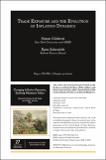Artículo
Trade exposure and the evolution of inflation dynamics
Fecha
2020Resumen
The Phillips curve—the relationship between price inflation
and fluctuations in economic activity— is a central building block
of economic models that allow for nominal rigidities and are relied
upon by central banks around the world to gauge cyclical inflationary
pressures and forecast inflation. The lack of deflationary pressures
during the Great Recession and, more recently, the apparent lack
of inflationary pressures during the recovery have brought into the
forefront the question of whether this relationship still exists in the
data.1 More generally, the fact that inflation appears to have become
less responsive to fluctuations in economic activity during the past
couple of decades has been documented for the United States by
Atkeson and Ohanian (2001), Roberts (2006), Mavroeidis and others
(2001), and Blanchard (2016).
Colecciones
Descargar

El ítem tiene asociados los siguientes ficheros de licencia:

